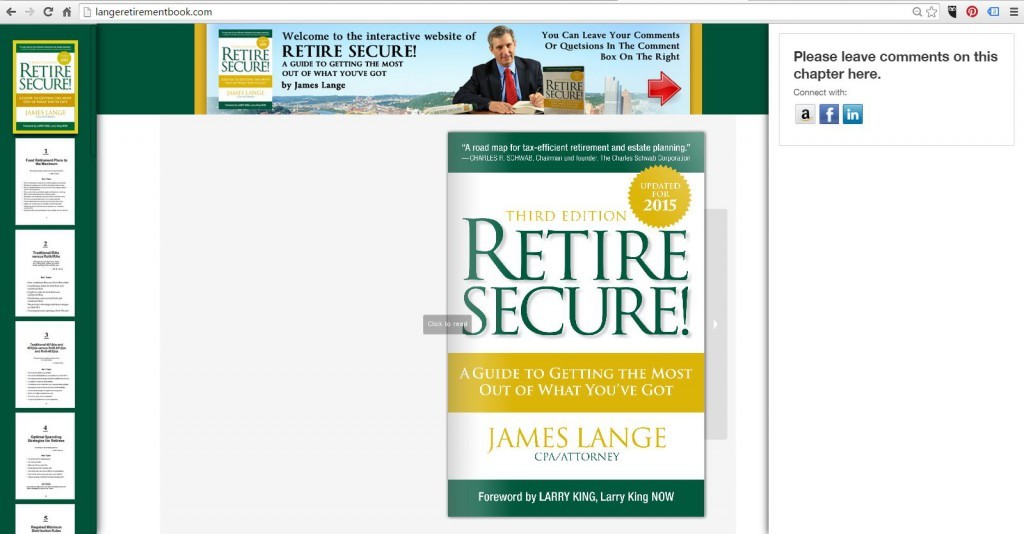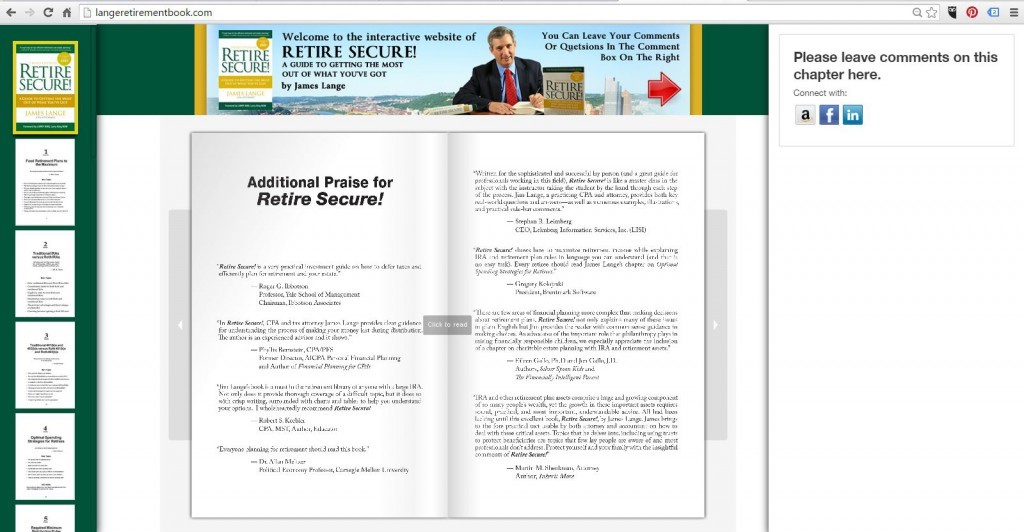 The ability to know what to do with an IRA or retirement plan beneficiary form can often be detrimental.
The ability to know what to do with an IRA or retirement plan beneficiary form can often be detrimental.
First, know we are on shaky ground. The conservative and proper legal advice is to request the client have their estate attorney fill out the beneficiary designation forms.
There are several advantages of having an estate attorney fill out the forms
- Eliminates or drastically reduces your exposure for not filling out the form correctly and consistent with the clients’ wishes
- Presumably, the estate attorney has a “big picture” of how the estate will be distributed and the IRA and retirement plan beneficiary designation is an important piece to that entire puzzle
For most traditional clients, I prefer the plan described in chapter 12 of Retire Secure! (Wiley, 2006). The chapter, “The Ideal Beneficiary Designation of Your Retirement Plan” describes what I consider the “master plan”.
Assume that you have a traditional family with children and grandchildren or even the potential to have grandchildren in the future. Let’s also assume that your client and their spouses trust each other completely and the client’s children are by now responsible adults (if not, see the discussion about trusts below).
Primary Beneficiary:
My spouse __________________
Contingent beneficiary
My children______________, ___________, and __________equally, per stirpes
Per stirpes is Latin for by representation. Adding per stirpes is critical. Let’s assume one of your client’s children either predeceases your client or your client’s child wants to disclaim a portion of the inherited IRA to their children, i.e. your client’s grandchildren. Without the words per stirpes, (assuming that the form does not have a box to check to indicate a per stirpes designation), the share of the predeceased or disclaiming child would not go to their children, but rather to their siblings, because the majority of beneficiary forms do not assume a per stirpes distribution unless you specifically state per stirpes in the designation. Presumably, most of your clients do not want to disinherit their grandchildren. Without per stirpes, you could have a grandchild that not only lost their parent, but also lost any inheritance they may have used for support, education, etc.
I also recommend putting current addresses and social security numbers on the IRA or retirement plan beneficiary designation.
Please note, however, that even this solution is only a partial and temporary solution. This solution still allows the possibility of having your client’s grandchild (or child if they are young) drinking $1,000 per bottle champagne to celebrate their purchase of a new Hummer on their 21st birthday.
So, to do the job right, you should name a well drafted trust, either a dedicated trust or a trust that is currently part of the client’s will or living trust, for the benefit of grandchildren (or children if client’s children are young and/or not sufficiently mature to handle an inheritance). In addition, you need at least one trust for each set of your client’s children’s children. There are lots of variations on these trusts, but for the IRA beneficiary purposes, they must meet 6 specific conditions in order to preserve the “stretch IRA” for the grandchildren.
Therefore, what will be a combination of practical, yet also proper advice is to fill out the forms the way I have suggested and recommend both orally and in writing that your client see a qualified estate planning attorney to properly fill out the IRA and retirement plan beneficiary forms.
-Jim
 A nationally recognized IRA, Roth IRA conversion, and 401(k) expert, he is a regular speaker to both consumers and professional organizations. Jim is the creator of the Lange Cascading Beneficiary Plan™, a benchmark in retirement planning with the flexibility and control it offers the surviving spouse, and the founder of The Roth IRA Institute, created to train and educate financial advisors.
A nationally recognized IRA, Roth IRA conversion, and 401(k) expert, he is a regular speaker to both consumers and professional organizations. Jim is the creator of the Lange Cascading Beneficiary Plan™, a benchmark in retirement planning with the flexibility and control it offers the surviving spouse, and the founder of The Roth IRA Institute, created to train and educate financial advisors.
Jim’s strategies have been endorsed by The Wall Street Journal (33 times), Newsweek, Money Magazine, Smart Money, Reader’s Digest, Bottom Line, and Kiplinger’s. His articles have appeared in Bottom Line, Trusts and Estates Magazine, Financial Planning, The Tax Adviser, Journal of Retirement Planning, and The Pennsylvania Lawyer magazine.
Jim is the best-selling author of Retire Secure! (Wiley, 2006 and 2009), endorsed by Charles Schwab, Larry King, Ed Slott, Jane Bryant Quinn, Roger Ibbotson and The Roth Revolution, Pay Taxes Once and Never Again endorsed by Ed Slott, Natalie Choate and Bob Keebler.
If you’d like to be reminded as to when the book is coming out please fill out the form below.
Thank you.
Save
Save





 The ability to know what to do with an IRA or retirement plan beneficiary form can often be detrimental.
The ability to know what to do with an IRA or retirement plan beneficiary form can often be detrimental. A nationally recognized IRA, Roth IRA conversion, and 401(k) expert, he is a regular speaker to both consumers and professional organizations. Jim is the creator of the Lange Cascading Beneficiary Plan™, a benchmark in retirement planning with the flexibility and control it offers the surviving spouse, and the founder of The Roth IRA Institute, created to train and educate financial advisors.
A nationally recognized IRA, Roth IRA conversion, and 401(k) expert, he is a regular speaker to both consumers and professional organizations. Jim is the creator of the Lange Cascading Beneficiary Plan™, a benchmark in retirement planning with the flexibility and control it offers the surviving spouse, and the founder of The Roth IRA Institute, created to train and educate financial advisors.

 I had some reservations about writing Chapter 16. Chapter 15 discusses the perils of filling out your own beneficiary forms, and Chapter 16 talks about filling out beneficiary forms. It sounds counter-intuitive, but there is a method to my madness!
I had some reservations about writing Chapter 16. Chapter 15 discusses the perils of filling out your own beneficiary forms, and Chapter 16 talks about filling out beneficiary forms. It sounds counter-intuitive, but there is a method to my madness! Give Your Heirs as Much Flexibility as Possible
Give Your Heirs as Much Flexibility as Possible

 Those of you who have been following me for a while know that that one of my most cherished mantras is “Pay Taxes Later!” An extension of that mantra was my recommendation that, upon your death, your beneficiaries continue to take advantage of the minimum distribution rules to “stretch” your IRA for as long as possible so that they could achieve the maximum tax-deferred growth possible. This used to be a fairly straightforward concept but, with the increase in second and third marriages, as well as non-traditional marriages, it has become much more complicated.
Those of you who have been following me for a while know that that one of my most cherished mantras is “Pay Taxes Later!” An extension of that mantra was my recommendation that, upon your death, your beneficiaries continue to take advantage of the minimum distribution rules to “stretch” your IRA for as long as possible so that they could achieve the maximum tax-deferred growth possible. This used to be a fairly straightforward concept but, with the increase in second and third marriages, as well as non-traditional marriages, it has become much more complicated.